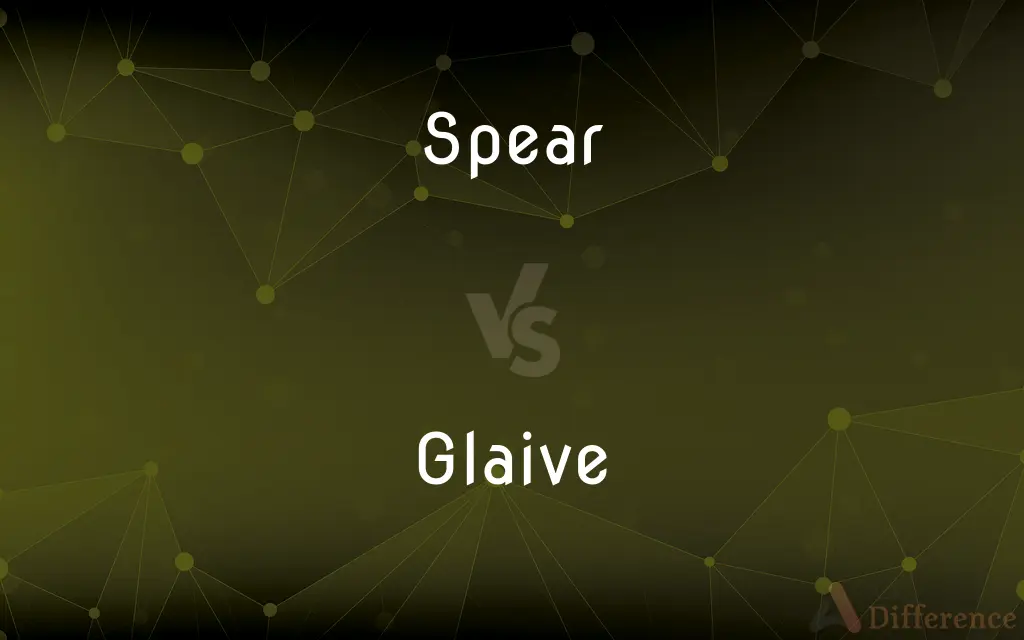Spear vs. Glaive — What's the Difference?
By Tayyaba Rehman & Maham Liaqat — Updated on March 21, 2024
A spear is a long, pointed weapon designed for thrusting or throwing, primarily used for piercing targets, while a glaive is a polearm with a single-edged blade on the end, used for slicing or chopping.

Difference Between Spear and Glaive
Table of Contents
ADVERTISEMENT
Key Differences
The spear is one of the oldest weapons used by humans, characterized by its long shaft and pointed tip, made from various materials such as wood, metal, or stone. In contrast, the glaive is a type of polearm that emerged in the Middle Ages, combining the reach of a spear with the cutting power of a sword.
While both leverage the advantage of reach, allowing the wielder to engage opponents from a safer distance, their methods of attack and defensive capabilities differ significantly. The spear's pointed tip is ideal for quick, direct strikes and can be used defensively to keep enemies at bay. On the other hand, the glaive's blade allows for a wider range of offensive maneuvers, including sweeping cuts and hooks, which can be particularly useful against multiple adversaries or when breaking through enemy lines.
The usage of spears and glaives also reflects their distinct tactical roles in historical battle formations. Spears were often used en masse, with formations like the phalanx or shield wall, capitalizing on their defensive capabilities and the power of massed thrusting attacks. Glaives, while also used in formations, were particularly valued for their versatility and the ability to inflict significant damage with slashing attacks, often wielded by specialized troops or bodyguards.
Today, both spears and glaives are primarily seen in historical reenactments, martial arts, and as ceremonial or decorative items. Their legacy, however, remains embedded in military history and culture, symbolizing the evolution of warfare technology through the ages.
Comparison Chart
Design
Long shaft with a pointed tip
Long handle with a single-edged blade
ADVERTISEMENT
Primary Use
Thrusting, piercing, and throwing
Slashing and chopping
Historical Usage
Widespread across cultures for hunting and warfare
Primarily used in the Middle Ages
Material
Wood, metal, or stone for the tip
Wooden handle with a metal blade
Combat Style
Effective in mass formations (e.g., phalanx)
Versatile in individual and group combat
Tactical Role
Piercing armor and keeping enemies at bay
Inflicting broad cuts and breaking lines
Defensive Capability
High, especially in formations
Moderate, with greater offensive versatility
Era
Ancient to modern
Medieval
Compare with Definitions
Spear
A weapon with a pointed tip for thrusting or throwing.
The warrior hurled a spear at the oncoming attacker.
Glaive
A medieval polearm with a curved blade.
The guard at the castle gate wielded a glaive.
Spear
Designed for piercing targets.
The spear's design was crucial for penetrating armor.
Glaive
Combines reach with cutting power.
The glaive was effective against lightly armored foes.
Spear
Used since prehistoric times for hunting and combat.
Spears were fundamental in ancient warfare tactics.
Glaive
Requires skill for effective use.
Mastery of the glaive was a mark of an experienced warrior.
Spear
Common in many cultures worldwide.
The Zulu warriors were renowned for their use of the assegai, a type of spear.
Glaive
Used for slashing and chopping.
The soldier used his glaive to cleave through the enemy's ranks.
Spear
Can be made from various materials.
Early spears had tips of flint or bone.
Glaive
Featured in European warfare.
Medieval knights sometimes carried glaives into battle.
Spear
A spear is a pole weapon consisting of a shaft, usually of wood, with a pointed head. The head may be simply the sharpened end of the shaft itself, as is the case with fire hardened spears, or it may be made of a more durable material fastened to the shaft, such as bone, flint, obsidian, iron, steel, or bronze (or other type of stone or metal).
Glaive
A glaive (or glave) is a European polearm, consisting of a single-edged blade on the end of a pole. It is similar to the Japanese naginata, the Chinese guandao and pudao, the Korean woldo, the Russian sovnya, and the Siberian palma.
Spear
A weapon with a pointed tip, typically of steel, and a long shaft, used for thrusting or throwing.
Glaive
A sword, especially a broadsword.
Spear
A plant shoot, especially a pointed stem of asparagus or broccoli
Smoked salmon wrapped around asparagus spears
Glaive
A light lance with a long, sharp-pointed head.
Spear
Pierce or strike with a spear or other pointed object
She speared her last chip with her fork
Glaive
(historical) A weapon consisting of a pole with a large blade fixed on the end, the edge of which is on the outside curve.
Spear
A weapon consisting of a long shaft with a sharply pointed end.
Glaive
A sword, particularly a broadsword.
Spear
A shaft with a sharp point and barbs for spearing fish.
Glaive
A weapon formerly used, consisting of a large blade fixed on the end of a pole, whose edge was on the outside curve; also, a light lance with a long sharp-pointed head.
Spear
A soldier armed with a spear.
Glaive
A sword; - used poetically and loosely.
The glaive which he did wield.
Spear
A slender stalk, as of asparagus.
Spear
To pierce with a spear or other sharp object.
Spear
To catch with a thrust of the arm
Spear a grounder.
Spear
(Football) To block (an opponent) by ramming with the helmet, in violation of the rules.
Spear
(Sports) To jab (an opponent) with the blade of a hockey stick, in violation of the rules.
Spear
To stab at something with a spear or other sharp object.
Spear
To sprout like a spear.
Spear
A long stick with a sharp tip used as a weapon for throwing or thrusting, or anything used to make a thrusting motion.
Spear
A soldier armed with such a weapon; a spearman.
Spear
A lance with barbed prongs, used by fishermen to retrieve fish.
Spear
(ice hockey) An illegal maneuver using the end of a hockey stick to strike into another hockey player.
Spear
(wrestling) In professional wrestling, a running tackle in which the wrestler's shoulder is driven into the opponent's midsection.
Spear
A shoot, as of grass; a spire.
Spear
The feather of a horse.
Spear
The rod to which the bucket, or plunger, of a pump is attached; a pump rod.
Spear
A long, thin strip from a vegetable.
Asparagus and broccoli spears
Spear
(botany) The sprout of a plant, stalk
Spear
(obsolete) A church spire.
Spear
(transitive) To pierce with a spear.
Spear
To penetrate or strike with, or as if with, any long narrow object; to make a thrusting motion that catches an object on the tip of a long device.
Spear
(gridiron football) To tackle an opponent by ramming into them with one's helmet.
Spear
(intransitive) To shoot into a long stem, as some plants do.
Spear
To ignore as a social snub.
Spear
Male.
A spear counterpart
Spear
Pertaining to male family members.
The spear side of the family
Spear
A long, pointed weapon, used in war and hunting, by thrusting or throwing; a weapon with a long shaft and a sharp head or blade; a lance.
They shall beat their swords into plowshares, and their spears into pruning hooks.
Spear
Fig.: A spearman.
Spear
A sharp-pointed instrument with barbs, used for stabbing fish and other animals.
Spear
A shoot, as of grass; a spire.
Spear
The rod to which the bucket, or plunger, of a pump is attached; a pump rod.
Spear
To shoot into a long stem, as some plants. See Spire.
Spear
A long pointed rod used as a weapon
Spear
An implement with a shaft and barbed point used for catching fish
Spear
Pierce with a spear;
Spear fish
Spear
Thrust up like a spear;
The branch speared up into the air
Common Curiosities
Did all cultures use spears?
While not absolutely all, spears are among the most universally used weapons in history due to their simplicity and effectiveness.
Was the glaive used by cavalry?
While primarily an infantry weapon, variations of polearms, similar to glaives, were used by cavalry for their reach and cutting capability.
Are spears effective against armored opponents?
Spears can be effective against armor, particularly when used with enough force to pierce through or target gaps in the armor.
How long were historical glaives?
Glaive lengths varied but typically ranged from about 6 to 8 feet (1.8 to 2.4 meters), allowing for reach while maintaining maneuverability.
Can a spear be used for defense?
Yes, the spear can be very effective defensively, especially in formation tactics like the phalanx, where it keeps opponents at a distance.
How did the design of spears evolve over time?
Spear designs evolved to include stronger, more durable materials for tips, and variations in shape and size to suit different tactical needs.
Were spears only used in combat?
No, spears were also widely used for hunting, leveraging their piercing capability to take down game.
Can spears and glaives be thrown?
Spears are often designed for throwing, whereas glaives, due to their construction and balance, are not typically used as thrown weapons.
What is the advantage of a glaive over a sword?
The main advantage is reach; a glaive can strike or defend against opponents beyond the effective range of a sword.
Is a glaive heavier than a spear?
Generally, yes, due to its larger blade, a glaive can be heavier than a spear, which is designed to be lightweight for throwing and quick thrusts.
How do you train to use a glaive effectively?
Training involves mastering balance, coordination, and the techniques for making effective slashing and chopping motions, often under the guidance of a skilled instructor.
Were glaives used in Asia?
Similar types of weapons to the glaive were used in Asia, such as the Japanese naginata, which shares functional characteristics with the glaive.
Are modern military forces still using spears or glaives?
Modern military forces do not use spears or glaives as standard weapons, but they may appear in ceremonial roles or as part of military history education.
Share Your Discovery

Previous Comparison
Cobalt vs. Coltan
Next Comparison
International vs. GlobalAuthor Spotlight
Written by
Tayyaba RehmanTayyaba Rehman is a distinguished writer, currently serving as a primary contributor to askdifference.com. As a researcher in semantics and etymology, Tayyaba's passion for the complexity of languages and their distinctions has found a perfect home on the platform. Tayyaba delves into the intricacies of language, distinguishing between commonly confused words and phrases, thereby providing clarity for readers worldwide.
Co-written by
Maham Liaqat















































